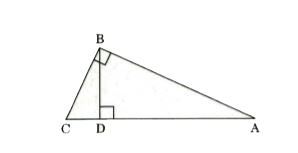In a triangle ABC, AD is perpendicular to BC and BE is perpendicular to AC. Which one of the following is correct ?
CE×CB×=CA×CD
CE×CA=CD×CB
AD×BD=AE×BE
AB×AC=AD×BE
To solve the problem, we need to analyze the given triangle ABC with the perpendiculars AD and BE. Let's break down the steps:
Step 1: Understand the Geometry
In triangle ABC:
- AD is drawn from vertex A to side BC, making it perpendicular to BC.
- BE is drawn from vertex B to side AC, making it perpendicular to AC.
Step 2: Identify Relevant Segments
Let:
- D be the foot of the perpendicular from A to BC.
- E be the foot of the perpendicular from B to AC.
- CE is the segment on AC from C to E.
- CD is the segment on BC from C to D.
Step 3: Apply the Area Relationship
The areas of triangles can be related through the heights and bases. The area of triangle ABC can be expressed in two ways:
1. Using height AD and base BC:
Area=12×BC×AD
2. Using height BE and base AC:
Area=12×AC×BE
Step 4: Establish the Proportional Relationship
From the properties of triangles, we can establish the following relationship based on the segments:
AC×CE=BC×CD
This indicates that the product of the segments on one side is equal to the product of the segments on the other side.
Step 5: Rearranging the Equation
Rearranging the equation gives us:
CE×AC=CD×BC
This shows a direct relationship between the segments created by the perpendiculars.
Step 6: Conclusion
From the analysis, we conclude that the correct relationship is:
CE×AC=CD×BC
Thus, the correct option is the one that states this relationship.
In triangle ABC:
- AD is drawn from vertex A to side BC, making it perpendicular to BC.
- BE is drawn from vertex B to side AC, making it perpendicular to AC.
Let:
- D be the foot of the perpendicular from A to BC.
- E be the foot of the perpendicular from B to AC.
- CE is the segment on AC from C to E.
- CD is the segment on BC from C to D.
The areas of triangles can be related through the heights and bases. The area of triangle ABC can be expressed in two ways:
1. Using height AD and base BC:
Area=12×BC×AD
2. Using height BE and base AC:
Area=12×AC×BE
From the properties of triangles, we can establish the following relationship based on the segments:
AC×CE=BC×CD
This indicates that the product of the segments on one side is equal to the product of the segments on the other side.
Rearranging the equation gives us:
CE×AC=CD×BC
This shows a direct relationship between the segments created by the perpendiculars.
From the analysis, we conclude that the correct relationship is:
CE×AC=CD×BC
Thus, the correct option is the one that states this relationship.
Similar Questions
Knowledge Check
In triangle ABC, AD is prependicular to BC and DE is perpendicular to AB
 AabcdprqqBabcdqrpsCabcdspqrDabcdrpsq
AabcdprqqBabcdqrpsCabcdspqrDabcdrpsqIf median of the ΔABC through A is perpendicular to BC, then which one of the following is correct ?
Atan A + tan B = 0Btan B - tan C = 0Ctan C + 2 tan A = 0Dtan B + tan C = 0In ΔABC,AB=AC,Ois a point on BC such that BO = CO and OD is perpendicular to AB and OE is perpendicular to AC. If ∠BOD=30∘ then measure of ∠AOE is
A45∘B60∘C75∘D30∘
In a ΔABC, if D is the mid point of BC and AD is perpendicular to AC, then cosB=
View SolutionABC is a triangle right angled at C with BC = a and AC = b. If p is the length of the perpendicular from C on AB, then which one of the following is correct ?
View SolutionIn the figure given below, ABC is a triangle with AB perpendicular to BC. Further BD is perpendicular to AC. If AD = 9 cm and DC = 4 cm, then what is the length of BD ?

View SolutionIn a △ABC,AB = AC and AD⊥BC, then :
View SolutionIn a trapezium ABCD, AB is a parallel to CD. BD is perpendicular to AD. AC is perpendicular to BC. If AD=BC=15cmandAB=25cm, then the area of the trapezium is :
View Solution
